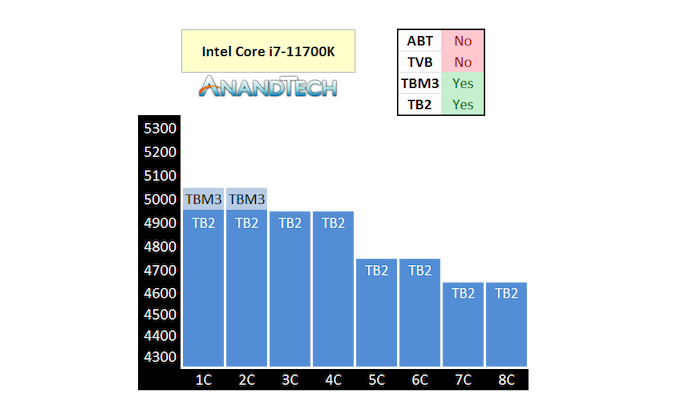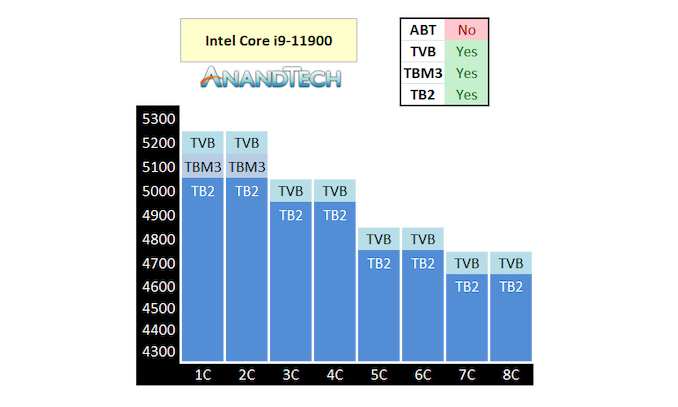Intel Rocket Lake (14nm) Review: Core i9-11900K, Core i7-11700K, and Core i5-11600K
by Dr. Ian Cutress on March 30, 2021 10:03 AM EST- Posted in
- CPUs
- Intel
- LGA1200
- 11th Gen
- Rocket Lake
- Z590
- B560
- Core i9-11900K
Intel’s New Adaptive Boost Technology for Core i9-K/KF
Taken from our news item
To say that Intel’s turbo levels are complicated to understand is somewhat of an understatement. Trying to teach the difference between the turbo levels to those new to measuring processor performance is an art form in of itself. But here’s our handy guide, taken from our article on the subject.
Adaptive Boost Technology is now the fifth frequency metric Intel uses on its high-end enthusiast grade processors, and another element in Intel’s ever complex ‘Turbo’ family of features. Here’s the list, in case we forget one:
| Intel Frequency Levels | ||
| Base Frequency | - | The frequency at which the processor is guaranteed to run under warranty conditions with a power consumption no higher than the TDP rating of the processor. |
| Turbo Boost 2.0 | TB2 | When in a turbo mode, this is the defined frequency the cores will run at. TB2 varies with how many cores are being used. |
| Turbo Boost Max 3.0 | TBM3 'Favored Core' |
When in a turbo mode, for the best cores on the processor (usually one or two), these will get extra frequency when they are the only cores in use. |
| Thermally Velocity Boost | TVB | When in a turbo mode, if the peak thermal temperature detected on the processor is below a given value (70ºC on desktops), then the whole processor will get a frequency boost of +100 MHz. This follows the TB2 frequency tables depending on core loading. |
| Adaptive Boost Technology | ABT 'floating turbo' |
When in a turbo mode, if 3 or more cores are active, the processor will attempt to provide the best frequency within the power budget, regardless of the TB2 frequency table. The limit of this frequency is given by TB2 in 2-core mode. ABT overrides TVB when 3 or more cores are active. |
| *Turbo mode is limited by the turbo power level (PL2) and timing (Tau) of the system. Intel offers recommended guidelines for this, but those guidelines can be overridden (and are routinely ignored) by motherboard manufacturers. Most gaming motherboards will implement an effective ‘infinite’ turbo mode. In this mode, the peak power observed will be the PL2 value. It is worth noting that the 70ºC requirement for TVB is also often ignored, and TVB will be applied whatever the temperature. | ||
Intel provided a slide trying to describe the new ABT, however the diagram is a bit of a mess and doesn’t explain it that well. Here’s the handy AnandTech version.
First up is the Core i7-11700K that AnandTech has already reviewed. This processor has TB2, TBM3, but not TVB or ABT.
The official specifications show that when one to four cores are loaded, when in turbo mode, it will boost to 4.9 GHz. If it is under two cores, the OS will shift the threads onto the favored cores and Turbo Boost Max 3.0 will kick in for 5.0 GHz. More than four core loading will be distributed as above.
On the Core i9-11900, the non-overclocking version, we also get Thermal Velocity Boost which adds another +100 MHz onto every core max turbo, but only if the processor is below 70ºC.
We can see here that the first two cores get both TBM3 (favored core) as well as TVB, which makes those two cores give a bigger jump. In this case, if all eight cores are loaded, the turbo is 4.6 GHz, unless the CPU is under 70ºC, then we get an all-core turbo of 4.7 GHz.
Now move up to the Core i9-11900K or Core i9-11900KF, which are the only two processors with the new floating turbo / Adaptive Boost Technology. Everything beyond two cores changes and TVB no longer applies.
Here we see what looks like a 5.1 GHz all-core turbo, from three cores to eight cores loaded. This is +300 MHz above TVB when all eight cores are loaded. But the reason why I’m calling this a floating turbo is because it is opportunistic.
What this means is that, if all 8 cores are loaded, TB2 means that it will run at 4.7 GHz. If there is power budget and thermal budget, it will attempt 4.8 GHz. If there is more power budget and thermal budget available, it will go to 4.9 GHz, then 5.0 GHz, then 5.1 GHz. The frequency will float as long as it has enough of those budgets to play with, and it will increase/decrease as necessary. This is important as different instructions cause different amounts of power draw and such.
If this sounds familiar, you are not wrong. AMD does the same thing, and they call it Precision Boost 2, and it was introduced in April 2018 with Zen+. AMD applies its floating turbo to all of its processors – Intel is currently limiting floating turbo to only the Core i9-K and Core i9-KF in Core 11th Gen Rocket Lake.
One of the things that we noticed with AMD however is that this floating turbo does increase power draw, especially with AVX/AVX2 workloads. Intel is likely going to see similar increases in power draw. What might be a small saving grace here is that Intel’s frequency jumps are still limited to full 100 MHz steps, whereas AMD can do it on the 25 MHz boundary. This means that Intel has to manage larger steps, and will likely only cross that boundary if it knows it can be maintained for a fixed amount of time. It will be interesting to see if Intel gives the user the ability to change those entry/exit points for Adaptive Boost Technology.
There will be some users who are already familiar with Multi-Core Enhancement / Multi-Core Turbo. This is a feature from some motherboard vendors have, and often enable at default, which lets a processor reach an all-core turbo equal to the single core turbo. That is somewhat similar to ABT, but that was more of a fixed frequency, whereas ABT is a floating turbo design. That being said, some motherboard vendors might still have Multi-Core Enhancement as part of their design anyway, bypassing ABT.
Overall, it’s a performance plus. It makes sense for the users that can also manage the thermals. AMD caught a wind with the feature when it moved to TSMC’s 7nm. I have a feeling that Intel will have to shift to a new manufacturing node to get the best out of ABT, and then we might see the feature on the more mainstream CPUs, as well as becoming default as standard.













279 Comments
View All Comments
Oxford Guy - Saturday, April 3, 2021 - link
Since you are interested in playing Mr. Censor I can give you some advice. Instead of campaigning to have this site degraded to be like Ars and Slashdot — echo chambers of post hiding and clique voting, there are more than enough sites like that where you can find that kind of entertainment.I doubt that this site is going to change the comments system into one of those echo chambers for you. But, I can’t stop you from continuing your peevish inept censorship campaign.
Qasar - Saturday, April 3, 2021 - link
nor will it ever change no matter how you whine and complain about everything, just to give you some thing to whine and complain about, whats your point :-)marsdeat - Tuesday, March 30, 2021 - link
Slight error on page 1: "it really has to go against the 12-core Ryzen 9 5900X, where it loses out by 50% on cores but has a chance to at least draw level on single thread performance."No, it loses out by 33% on cores, or the 5900X has 50% more cores. The 11900K doesn't lose by 50% on cores.
factual - Tuesday, March 30, 2021 - link
At this point in time, the best bang for buck CPU is 10700K (At least in Canada). There's no point in wasting money on 11th gen Intel CPUs, you are better off paying the premium for the Ryzen 5000 instead of buying 11th gen Intel.Fulljack - Wednesday, March 31, 2021 - link
or 10700F if you already have GPU. it's much cheaper even against older 3700X in my country.JayNor - Tuesday, March 30, 2021 - link
While ABT may be hard for Intel to explain, the description chart in this article indicates that a good cooler + enabled ABT might provide an interesting benchmark result, especially if this is effectively what AMD enables in their default configuration.Byte - Tuesday, March 30, 2021 - link
Rocket lake is akin to Nvidias Turing, hard pass generation of chips. Unless you really really can't wait a year. But then again, maybe you can buy it.jeremyshaw - Tuesday, March 30, 2021 - link
Turing was at least consistently faster than their predecessors in the consumer space (and could still claim #1 gaming against its contemporaries). Just being #1, in and of itself, is reason enough to exist. Turing also didn't move the needle in price/perf, but it didn't regress, either. Rocket Lake does not have any real performance angle to hold onto, outside of the narrow AVX512 market (is it even a market?), and its price/perf is worse in many aspects (and that's just MSRP to MSRP, nevermind street prices).AdamK47 - Tuesday, March 30, 2021 - link
2080 Ti?What going on over there at AnandTech?
Slash3 - Tuesday, March 30, 2021 - link
That 2080 Ti is almost brand new to AT, too. Game tests until recently had been done with a GTX 1080. It's not really their wheelhouse at this point and I think they're more than aware. It's ok, the gap has long since been filled.